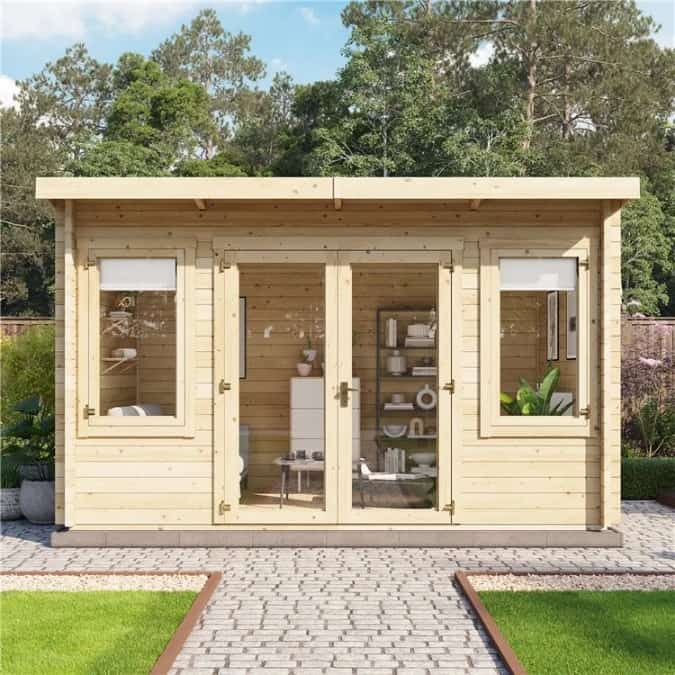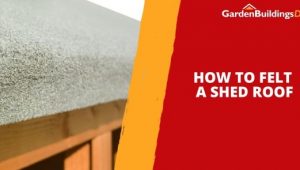Jump to:
Are you an artist yearning for a serene sanctuary where creativity can flow freely? Imagine having your very own art studio nestled in the tranquillity of your garden. A place where inspiration blooms with every brushstroke and imagination takes flight. Cue a garden cabin art studio.
In this guide, we’ll walk you through the exciting journey of creating your dream artist’s haven. Whether you’re an experienced artist or just starting your creative journey, we’ve got you!
Planning and Preparation

To plan and prepare for building a log cabin studio, follow these key steps:
1. Assess your needs
Determine your specific requirements, such as:
- the amount of space needed
- storage requirements
- desired amenities
Envision how you want the studio to function and the atmosphere you wish to create.
2. Choose the right location
Select a suitable spot in your garden that offers privacy and natural light. On top of these, you’ll also want somewhere with a peaceful environment. Other factors to consider include the following:
- accessibility
- proximity to utilities
- any potential obstacles or landscaping adjustments
3. Size, style, and materials
When it comes to selecting a garden outhouse cabin, you’ll need to consider three key aspects. First is the size; log cabins come in various dimensions. Your options include:
- Small: Ideal for cosy, compact gardens. These can be as small as a garden shed or a bit larger, perfect for storage or a small workspace.
- Medium: Suitable for medium-sized gardens. They offer more space for multiple uses, such as a garden office or a hobby room.
- Large: Perfect if you have a spacious garden. A large log cabin can serve as a luxurious extension of your living space. It provides ample room for diverse activities other than as an art studio.
Next is the different roof styles:
- Pent roof: This modern, single-sloped design works well in contemporary settings. The pent design ensures efficient rainwater drainage.
- Apex roof: The classic gable roof design looks timeless. Moreover, it maximises interior space and offers great ventilation.
As for the materials, focus on longevity and insulation. At Garden Buildings Direct, we offer the following:
- Pressure-treated wood: As the name suggests, it’s treated for durability. This means it withstands weather and pests, extending the cabin’s life. Check out our range of pressure treated log cabins for inspiration.
- Insulated log cabins: These structures provide year-round usability. They feature superior temperature control, making them suitable for art studios.
Carefully assess these factors to choose the perfect log cabin for your dream art studio.
4. Research local regulations
Before building your garden art studio, it’s crucial to research local regulations. Check local building codes to ensure your cabin complies with the law. You may need permits or approvals, depending on your area. Also, consider factors like:
- permissible size and height
- distance from property boundaries
- required permits or approvals
- whether the cabin can be used year-round or just seasonally
Examine rules regarding utilities like water and electricity connections. Plus, any specific guidelines for insulation and construction materials.
Take time to understand any specific restrictions that might be in place. Staying informed about local rules will help you avoid potential legal issues. Plus, you can ensure a smooth construction process for your creative space.
Constructing Your Garden Cabin

Here’s a step-by-step process for building your art studio:
1. Site preparation
Begin by clearing the chosen garden site. Remove debris and make sure the surface is levelled. Mark the studio’s precise footprint boundaries using stakes or markers. This critical step ensures a solid and secure foundation for your art studio.
2. Foundation and flooring
Choose the appropriate foundation type based on your cabin studio’s needs:
- Concrete slabs: A solid, flat surface made of poured concrete. This foundation type offers durability and stability and is ideal for heavy structures.
- Piers: Raised columns that support the cabin, suitable for uneven terrain. Provides ventilation and minimises moisture contact.
- Raised platforms: A wooden deck-like structure lifted off the ground. It offers a stable base and is suited for a more natural look and easier assembly on level ground.
Next, install the flooring material of your choice:
- Hardwood: A natural wood flooring known for durability, warmth, and aesthetics. However, it often requires more maintenance.
- Laminate: Engineered wood or composite flooring alternative. It offers durability, ease of maintenance, and various design options.
- Tiles: Hard-wearing ceramic or porcelain options, available in numerous styles. Easy to clean but may require a level surface for installation.
A stable foundation and suitable flooring provide the groundwork for a functional space.
3. Framing the structure
Build the walls, roof, and any additional structural components according to your design. Proper insulation is key for maintaining a comfortable temperature in your studio. Consider adding windows and doors strategically to harness natural light. Doing so can also ensure adequate ventilation, creating an inspiring workspace.
4. Installing utilities
Plan for essential utilities, starting with electrical wiring and fixtures. Position outlets strategically to power your art equipment effectively. If your creative process involves water usage, consider adding plumbing. Such an addition enables you to accommodate a sink or other water sources within your studio.
5. Insulate and weatherproof
Prioritise comfort and efficiency by installing insulation. This effective add-on is key to regulating temperature and soundproofing your studio. Consider using materials like:
- Fibreglass: Glass fibres provide efficient thermal and acoustic insulation. Common in rolls or batts, it’s cost-effective and easy to install.
- Foam board: Rigid foam panels, often made of polystyrene or polyurethane. Offers excellent thermal insulation and moisture resistance.
- Mineral wool: Made from stone or slag. It provides both thermal and acoustic insulation with fire-resistant properties. It comes in batts, boards, or loose-fill form.
Apply weatherproofing materials on the exterior to guard against moisture and external elements. This will safeguard your workspace and artistic creations.
6. Interior finishing
Enhance the interior by adding drywall, paint, or other wall finishes. Select a colour scheme that fosters creativity and imparts a pleasant ambience. This step transforms your space into an inviting haven for artistic pursuits.
7. Flooring and finishes
If not done earlier, lay down the chosen flooring material. To complete the look, add baseboards, trim, and any desired finishes. These finishing touches provide a polished, cohesive appearance to your art studio. They ensure it’s not just functional but aesthetically pleasing, too.
Essential construction materials and tools
Construction materials:
- Lumber (for framing)
- Insulation (such as fibreglass or foam)
- Plywood or drywall (for walls and ceilings)
- Roofing materials (shingles, metal sheets, etc.)
- Flooring material (hardwood, laminate, tiles, etc.)
- Electrical wiring and fixtures
- Plumbing materials (if needed)
- Weatherproofing materials (caulk, sealant, etc.)
- Paint and finishing materials
Essential tools:
- Measuring tape
- Level
- Hammer
- Screwdriver and drill
- Saw (circular saw, jigsaw, or mitre saw)
- Nail gun or hammer and nails
- Utility knife
- Safety equipment (goggles, gloves, etc.)
- Ladder or scaffolding
- Electrical tools (wire stripper, voltage tester, etc.)
- Plumbing tools (pipe wrench, pliers, etc.)
The items you need will depend on what type of construction you’re going for. But generally, these will provide you with a solid foundation to begin building.
Designing Your Art Studio

To design your art studio, consider the following aspects:
Explore design options
Choose a design style that resonates with your taste and artistic preferences. Here are some ideas for log cabins:
- Rustic charm: Embrace a cosy and traditional aesthetic with a cabin-style design. Feature natural wood finishes, a pitched roof, and rustic accents.
- Modern minimalism: Opt for a sleek and contemporary design. Focus on clean lines, large windows for ample natural light, and minimalist decor.
- Bohemian retreat: Create an eclectic and artistic atmosphere. Highlight vibrant colours, unique patterns, and a mix of textures that exude a Boho vibe.
- Scandinavian: Embrace simplicity and functionality. Feature light-coloured walls, minimalist furniture, and a focus on natural materials.
Optimise layout, lighting, and ventilation
Design a layout that maximises your productivity and inspiration. Strategically position work surfaces, easels, and storage areas to create an efficient workflow. Incorporate ample natural light through windows or skylights. Plan for artificial lighting to ensure adequate illumination. Also, prioritise proper ventilation to maintain a fresh and comfortable atmosphere.
Select suitable storage solutions
Evaluate your storage needs for art supplies and materials. Opt for storage options that are practical, tidy, and readily accessible. Installing shelving or storage units can help keep your creative space clutter-free. This also makes it easier to locate and use your materials when inspiration strikes.
Incorporate ergonomic considerations
Prioritise your physical comfort and well-being by investing in ergonomic elements. Choose seating that promotes good posture and reduces strain during long creative sessions. An adjustable desk accommodates various art forms and allows you to work in a way that suits your needs. Additionally, plan the placement of your supplies strategically to minimise reaching and discomfort.
Round-up
This DIY journey intertwines nature, creativity, and personal expression. From the initial planning stages to the final brushstroke, this guide has provided you with the steps and considerations.
Are you ready to set up a space that fosters artistic inspiration and productivity? May your garden log cabin art studio be a haven where your artistic journey unfolds!
Explore our selection of insulated log cabins, perfect for design inspiration. For instance, the Natura Pinnacle Garden Room features captivating floor-to-ceiling windows. They envelop the cabin’s front, flooding the interior with abundant natural light.
Discover more inspiring options for your garden space at Garden Buildings Direct today! Next on your reading list: How Insulated Are Log Cabins? Shop Log Cabins




